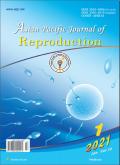Recurrent ovarian endometrioma after conservative surgery: A retrospective study
IF 0.6
Q4 REPRODUCTIVE BIOLOGY
引用次数: 0
Abstract
Objective: To study the prevalence and associated factors of recurrent ovarian endometrioma after ovarian cystectomy. Methods: This retrospective study analyzed 303 patients who underwent cystectomy for ovarian endometrioma and had at least a 2-year follow-up at Srinagarind Hospital from January 2013 to December 2018. The patients were divided into the recurrent and nonrecurrent groups according to the findings from postoperative transvaginal ultrasonography 6 months after undergoing surgery. Nineteen factors were collected for risk evaluation. The prevalence of recurrent ovarian endometrioma and its 95% confident interval (CI) were calculated. Univariate and multivariable logistic regression analyses were performed to determine the association between factors and recurrence. Results: Recurrent ovarian endometrioma occurred in 33% (95% CI 27.7%-38.3%) patients. The median duration of follow-up was 36 months. during the median follow-up period of 36 months. Preoperative history of parity, preoperative infertility history, endometriosis surgery, moderate to severe dysmenorrhea, dyspareunia, intraoperative stage 4 according to revised American Society for Reproductive Medicine classification, presence of adenomyosis, and postoperative pain relief were associated factors based on univariate analysis. In contrast, infertility [odds ratio (OR) 2.22, 95% CI 1.14-4.33], moderate to severe dysmenorrhea (OR 2.13, 95% CI 1.09-4.15), and postoperative pelvic pain relief (OR 0.22, 95% CI 0.12-0.42) were independently associated factors based on multivariable logistic regression analysis. Conclusions: In our setting, preoperative infertility history and moderate to severe dysmenorrhea were associated with a higher recurrent ovarian endometrioma risk. In contrast, postoperative pain relief was significantly associated with lower recurrence risk.保守手术后复发性卵巢子宫内膜瘤的回顾性研究
目的:探讨卵巢囊肿切除术后复发性卵巢子宫内膜异位瘤的发生率及相关因素。方法:本回顾性研究分析了2013年1月至2018年12月在斯利那加医院接受卵巢子宫内膜瘤膀胱切除术并至少随访2年的303名患者。根据术后6个月经阴道超声检查结果,将患者分为复发组和非复发组。收集了19个因素进行风险评估。计算复发性卵巢子宫内膜瘤的患病率及其95%置信区间(CI)。进行单变量和多变量逻辑回归分析,以确定因素与复发之间的相关性。结果:复发性卵巢子宫内膜异位瘤发生率为33%(95%CI 27.7%-38.3%)。中位随访时间为36个月。中位随访期36个月。基于单因素分析,术前产程史、术前不孕史、子宫内膜异位症手术、中重度痛经、性交困难、根据修订的美国生殖医学学会分类的术中4期、子宫腺肌症的存在和术后疼痛缓解是相关因素。相反,不孕[比值比(OR)2.22,95%CI 1.14-4.33]、中度至重度痛经(OR 2.13,95%CI 1.09-4.15)和术后盆腔疼痛缓解(OR 0.22,95%CI 0.12-0.42)是基于多变量逻辑回归分析的独立相关因素。结论:在我们的研究中,术前不孕史和中重度痛经与卵巢子宫内膜异位瘤复发的风险较高相关。相反,术后疼痛缓解与较低的复发风险显著相关。
本文章由计算机程序翻译,如有差异,请以英文原文为准。
求助全文
约1分钟内获得全文
求助全文
来源期刊

Asian Pacific Journal of Reproduction
Veterinary-Veterinary (all)
CiteScore
1.70
自引率
0.00%
发文量
588
审稿时长
9 weeks
期刊介绍:
The journal will cover technical and clinical studies related to health, ethical and social issues in field of Gynecology and Obstetrics. Articles with clinical interest and implications will be given preference.
 求助内容:
求助内容: 应助结果提醒方式:
应助结果提醒方式:


